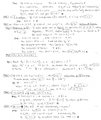12-240/Classnotes for Thursday September 13: Difference between revisions
| Line 19: | Line 19: | ||
'''F3:''' the existence of identity elements |
'''F3:''' the existence of identity elements |
||
<math>\forall \!\,</math> a <math>\in \!\,</math> F, a+o=a and a.1=a |
<math>\forall \!\,</math> a <math>\in \!\,</math> F\0, a+o=a and a.1=a |
||
Revision as of 11:45, 14 September 2012
| |||||||||||||||||||||||||||||||||||||||||||||||||||||||||
In the second day of the class, the professor continues on the definition of a field.
Definition of a field
Combined with a part from the first class, we have a complete definition as follow:
A field is a set "F' with two binary operations +,x defind on it, and two special elements 0 ≠ 1 such that
F1: commutative law
a, b F: a+b=b+a and a.b=b.a
F2: associative law
a, b, c F: (a+b)+c=a+(b+c) and (a.b).c= a.(b.c)
F3: the existence of identity elements
a F\0, a+o=a and a.1=a
F4: existence of inverses
a F , c, d F such that a+c=o and a.d=1
F5: contributive law
a, b, c F, a.(b+c)=a.b + a.c
Significance
Identity uniqueness
It makes sense to define an operation -: F -> F called "negation"
For a F define -a to be equal that b F for which a+b=0, i.e, a+(-a)=0
Ex: F(5)={0,1,2,3,4}, define +,x
Question: What is(-3)?
Answer: -3=2







